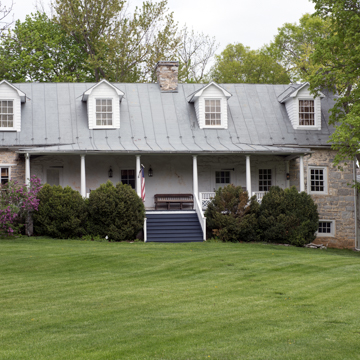You are here
White House (White House Tavern)
Part of this vernacular one-and-one-half-story, random rubble limestone house—presumably the east half, with its small windows—is one of West Virginia's oldest dwellings. The west section, apparently built as a separate unit, has larger window openings. The smooth wall surface between the two sections suggests that originally an open dogtrot separated the two components and was later walled. Such an arrangement was normal in early log houses but unusual with stone construction. A narrow, shedroofed porch now fronts the house, and there are four dormer windows in the roof above.
James Taylor sketched the house during his 1864 trek through the Eastern Panhandle and rather accurately summarized it as a “one-story prolongation with attic.” Except for the longer porch and the addition of two dormers on the western portion, the basic form has changed little since he drew it.
Dr. John McCormick, a graduate in medicine from the University of Dublin, built the house soon after he purchased the land in 1740. A later owner converted the house to a tavern. A group of early farm buildings, including a large stone barn (shown in Taylor's 1864 sketch) and a stone smokehouse, remain. A stone springhouse across the road, which Taylor also drew, contains the bold headspring of the south fork of Bullskin Run and was undoubtedly the reason the house was built where it was. The group forms a significant example of first-settlement architecture in the Eastern Panhandle.
Writing Credits
If SAH Archipedia has been useful to you, please consider supporting it.
SAH Archipedia tells the story of the United States through its buildings, landscapes, and cities. This freely available resource empowers the public with authoritative knowledge that deepens their understanding and appreciation of the built environment. But the Society of Architectural Historians, which created SAH Archipedia with University of Virginia Press, needs your support to maintain the high-caliber research, writing, photography, cartography, editing, design, and programming that make SAH Archipedia a trusted online resource available to all who value the history of place, heritage tourism, and learning.

